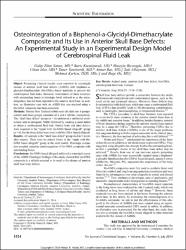| dc.contributor.author | Sanus, Galip Zihni | |
| dc.contributor.author | Kucukyuruk, Baris | |
| dc.contributor.author | Biceroglu, Huseyin | |
| dc.contributor.author | Isler, Cihan | |
| dc.contributor.author | Tanriverdi, Taner | |
| dc.contributor.author | Bas, Ahmet | |
| dc.contributor.author | Albayram, Sait | |
| dc.date.accessioned | 2019-11-26T20:14:12Z | |
| dc.date.available | 2019-11-26T20:14:12Z | |
| dc.date.issued | 2014 | |
| dc.identifier.issn | 1049-2275 | |
| dc.identifier.issn | 1536-3732 | |
| dc.identifier.uri | https://dx.doi.org/10.1097/SCS.0000000000000962 | |
| dc.identifier.uri | https://hdl.handle.net/20.500.12513/3831 | |
| dc.description | WOS: 000340257800139 | en_US |
| dc.description | PubMed ID: 24914756 | en_US |
| dc.description.abstract | Object: Promising clinical results were reported in watertight closure of anterior skull base defects (ASBDs) with bisphenol-a-glycidyl-dimethacrylate (bis-GMA)-based materials to prevent the cerebrospinal fluid leaks. However, interrelation of these materials with surrounding bones in histologic level, referred to as the osteo-integration, has not been reported in the anterior skull base. In addition, an illustrative case with an ASBD that was repaired using a bis-GMA composite has been presented. Methods: Twenty New Zealand rabbits were divided into 4 groups: control and sham groups consisted of 2 and 6 rabbits, respectively. The "skull base defect" group (n = 6) underwent a unifrontal craniectomy and an iatrogenic ASBD followed by creating a dural defect to obtain a cerebrospinal fluid leak. Similar bony and dural defects were acquired in the "repair with bis-GMA based allograft" group (n = 6), but the bony defect was closed with bis-GMA-based allograft. Results: All animals in the "skull base defect" group died in 3 weeks after surgery. There were no animal losses in the "repair with bis-GMA based allograft" group at the sixth month. Histologic evaluation revealed complete osteointegration of bis-GMA composite with surrounding bones. Conclusions: bis-GMA based allograft achieved a watertight repair of the ASBD. Histologic findings of this study showed that bis-GMA composite is a reliable material to be used in the closure of anterior skull base bony defects. | en_US |
| dc.language.iso | eng | en_US |
| dc.publisher | LIPPINCOTT WILLIAMS & WILKINS | en_US |
| dc.relation.isversionof | 10.1097/SCS.0000000000000962 | en_US |
| dc.rights | info:eu-repo/semantics/closedAccess | en_US |
| dc.subject | Animal study | en_US |
| dc.subject | anterior skull base defect | en_US |
| dc.subject | bis-GMA | en_US |
| dc.subject | cerebrospinal fluid leak | en_US |
| dc.subject | Cortoss | en_US |
| dc.title | Osteointegration of a Bisphenol-a-Glycidyl-Dimethacrylate Composite and Its Use in Anterior Skull Base Defects: An Experimental Study in an Experimental Design Model of Cerebrospinal Fluid Leak | en_US |
| dc.type | article | en_US |
| dc.relation.journal | JOURNAL OF CRANIOFACIAL SURGERY | en_US |
| dc.contributor.department | Kırşehir Ahi Evran Üniversitesi, Tıp Fakültesi, Dahili Tıp Bilimleri, Nöroloji ABD | en_US |
| dc.identifier.volume | 25 | en_US |
| dc.identifier.issue | 4 | en_US |
| dc.identifier.startpage | 1524 | en_US |
| dc.identifier.endpage | 1528 | en_US |
| dc.relation.publicationcategory | Makale - Uluslararası Hakemli Dergi - Kurum Öğretim Elemanı | en_US |


















